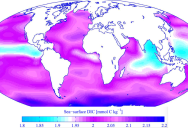Multiple Environmental Startups Are Working On Ways To Help The Ocean Naturally Remove CO2 From The Atmosphere

When trying to stop, or even just slow down, climate change, there are many things that can be done.
Many of them, like moving to renewable energy, improving efficiency, and even recycling are already being implemented around the world.
Unfortunately, that does not seem to be enough to offset the massive amounts of greenhouse gasses that are produced each year.
So, what else can be done to deal with these gasses?
According to a report in the Wall Street Journal, a number of startup companies, the obvious answer is to put the CO2 in the ocean.
Granted, that idea can seem terrible, especially given the fact that rising CO2 levels in the ocean has already caused damage to sea life, but it might actually work.
The world’s oceans absorb and trap around 25 to 30 percent of atmospheric carbon already.
This oceanic carbon cycle is the natural way that the environment deals with carbons in the atmosphere, and it has for millions of years.
The problem is that with man made CO2 in the atmosphere, it can’t deal with the sheer volume of it quickly enough.

Don’t worry, these environmental startups don’t want to force even more carbon into the oceans. Instead, they want to use various techniques to safely remove carbon from seawater, which would free up its capacity to naturally absorb more from the air.
This could work because it is much easier and more efficient to pull excess carbon from water than it is from the air.
One startup, for example, is working on an electrochemical technique that is able to pull the CO2 from seawater safely.
Another firm has a way to dissolve the mineral olivine (which is very common) into seawater, which can help to draw out the CO2.
Once the CO2 is removed from the seawater, it can be safely stored in various ways. It can even be converted into a solid material that is commonly used in construction jobs.
Estimates suggest that these methods could remove over a million metric tons of CO2 from the oceans, which then allows the oceans to do what they do best: pull excess CO2 from the air.
If these methods work as planned, the could be further scaled up in order to hopefully get to the point where all the CO2 that humans create is pulled from the environment using this type of cycle.
Of course, additional research, testing, and funding is going to be needed to make this a reality.
If all goes according to plan, this could be a great tool in the fight against climate change.
Thought that was fascinating? Here’s another story you might like: Why You’ll Never See A Great White Shark In An Aquarium

Sign up to get our BEST stories of the week straight to your inbox.




